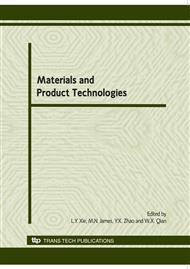[1]
Gross, M.D., Ervin, S.M., Anderson, J.A., and Fleisher, A. Design Studies Vol. 9, p.13(1998).
Google Scholar
[2]
O'Sullivan, B (2002). Constraint-Aided Conceptual Design, Professional Engineering Publishing Limited, London.
Google Scholar
[3]
Mayer, M. A. Creativity loves constraints. Business Week online February 13, (2006).
Google Scholar
[4]
Pahl G., Beitz W Engineering Design: A Systematic Approach, Second Edition, Springer (1996).
Google Scholar
[5]
Medland, A. J., Matthews, J and Mullineux, G. International Journal of Computer Integrated Manufacture, Vol. 22(3): p.199 (2008).
Google Scholar
[6]
Mullineux, G., Hicks, B. J and Medland, A. J. Constraint-aided product design. Acta Polytechnica: Journal of Advanced Engineering, Vol. 45, p.31 (2005).
DOI: 10.14311/702
Google Scholar
[7]
Hicks. B.J., Medland. A. J and Mullineux. G. Packaging technology and science, Vol. 14, p.209 (2001).
Google Scholar
[8]
Neale, G., Mullineux, G., Matthews, J and Medland, A. J. Proceedings of IMechE part B: Journal of manufacture. Vol. 223, p.207 (2009).
Google Scholar
[9]
Simon, H. A The Sciences of the Artificial. MIT Press, Cambridge, Mass, 1st edition (1969).
Google Scholar
[10]
Matthews, J., Singh, B., Mullineux, G., Medland, A. J. Computers and Industrial Engineering. Vol 51, p.809 (2006).
Google Scholar
[11]
Medland, A. J and Matthews, J. Engineering with Computers. [in press] DOI.
Google Scholar
[10]
1007/s00366-009-0148-z (2009).
Google Scholar
[12]
Suh, N. The Principles of Design, Oxford University Press (1990).
Google Scholar
[13]
Pugh S (1991) Total design, Addison-Wesley Publishing Company, New York.
Google Scholar
[14]
Hubka V and Eder, E. W (1996) Design Science: Introduction to the Needs, Scope and Organization of Engineering Design Knowledge, Springer-Verlag, ISBN 3540199977.
Google Scholar
[15]
Wilhelm, S. Artificial Intelligence in Design, Analysis and Manufacture. Vol 19, p.201 (2005).
Google Scholar
[16]
Holland, A, O'Callaghan, B and O'Sullivan, B. Innovations in Applied Artificial Intelligence. (Lecture notes Vol 3029/2004) (2004).
Google Scholar
[17]
Deng, Y.M., Briton, G. M and Tor, S.B. Computer Aided design, p.889. (2004).
Google Scholar
[18]
Zhang , W, Tor, S. B and Briton, G. M. Journal of Intelligent Manufacture. Vol 12, p.119 (2002).
Google Scholar
[19]
Thornton, A.C. Research in Engineering Design. 8(1): 1-13 (1996).
Google Scholar
[20]
Rudolph, S and Bolling, M. Aerospace Science and Technology, Vol 8 p.333 (2004).
Google Scholar
[21]
Yin, R, K (2003) Case study research: design and methods 2nd edition. Sage Publishing London.
Google Scholar


